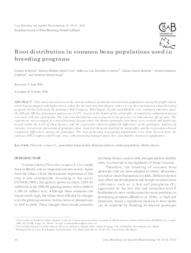Root distribution in common bean populations used in breeding programs.
Root distribution in common bean populations used in breeding programs.
Author(s): ROCHA, F. da; COAN, M. M. D.; COIMBRA, J. L. M.; BERTOLDO, J. G.; GUIDOLIN, A. F.; KOPP, M. M.
Summary: This study aimed to assess the root distribution of mutant common bean populations along the profile and to select bean genotypes with higher metric values for the trait root distribution, with a view to their inclusion in a bean breeding program. In this field study the genotypes IPR Uirapuru, IPR Chopim, Pérola and IAPAR 81 were evaluated and three doses (0, 100 and 200 Gy) of mutagen gamma rays (Co60), nested in the depths of the soil profile. A completely randomized design was used with two replications. The trait root distribution was measured in the presence (1) and absence (0) of roots. The experiment was arranged in a mixed factorial design where the factors genotypes and doses were crossed and depth was nested within the levels of these factors, and the regressions showed significant differences of the genotypes. Analysis of variance revealed an interaction of genotype x dose, nested in the factor depth of the soil profile, and the regressions showed significant differences among the genotypes. The most promising segregating populations were those derived from the cultivars IPR Uirapuru and Pérola, since with increasing mutagen doses their root number increased significantly.
Publication year: 2010
Types of publication: Journal article
Unit: Embrapa Dairy Cattle
Observation
Some of Embrapa's publications are published as ePub files. To read them, use or download one of the following free software options to your computer or mobile device. Android: Google Play Books; IOS: iBooks; Windows and Linux: Calibre.
Access other publications
Access the Agricultural Research Database (BDPA) to consult Embrapa's full library collection and records.
Visit Embrapa Bookstore to purchase books and other publications sold by Embrapa.

